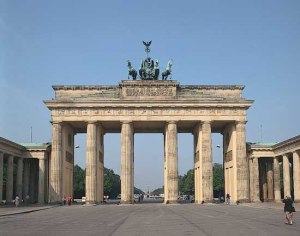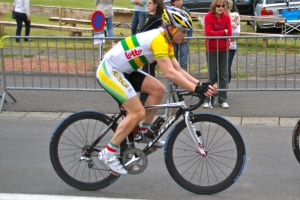I started training again in 2009, almost 20 years since I last raced my bike at an elite level. We were still living in Berlin, and I would ride my bike from where we lived in Prenzlauerberg on the East side of the city and out into the countryside. The outer suburbs of the east side of Berlin are a mix of turn of the century apartment buildings that survived the war, and housing and factories built during the GDR times. I would pass through Weissensee and Bernau, and then do a loop through the fields and a small forest near to Melchow and Biesenthal. On longer rides I might go as far as Eberswalde.
I tried not to get lost, as these were the days before I had a bike GPS and my German was non-existent. If you did ask someone for directions, the usual response was for the person to ask (in German) what kind of an idiot would ride with a map they could not read, and then point you in the wrong direction. The people out this way were Prussian, and they did not like the 'outsiders' like me who were coming to Berlin, forcing up prices and gentrifying many of the formerly working-class inner city suburbs.
The small rural villages in this part of Brandenburg were tidy and well kept, but far from affluent. Young people were notable by their absence, and you were more likely to see Dacia Logan sedans than BMWs. I would occasionally come across Confederate flags from the American civil war fluttering over small isolated houses out in the countryside, and my German friends later told me that these belonged to far-right supporters or neo-Nazis. I’m glad I didn’t stop at those places and ask for directions – the angry looking Rottweiler dogs in the front gardens would have deterred me anyway.
For the first several months that I rode my bike I didn't have any special training plan or goals. I just wanted to ride, and I loved my time alone. I started riding in the early Spring of 2009, and the temperatures were frequently hovering around zero. I would leave home with layers of clothing, thick winter gloves and a thermal hat under my helmet. My cheeks would sometimes start to burn on the really cold days, so I also got myself a balaclava. Looking back now, I’m not surprised the local village folk sometimes got a shock when I asked for directions.
My first goal was just to build-up my aerobic fitness and lose weight. This is what cyclists call base training, and at first I was doing just four or five hours per week. Trying to fit in some riding around my young family and intensive work schedule was not easy, so I often headed out very early in the morning. I also got myself an indoor trainer, and would try to ride on it once or twice a week in the evenings.
The best thing that I discovered about being back on my bike was the thinking time. I had become so busy in trying to juggle the three balls of family, career and self, that the third one had been the first to drop. This meant that I was occupied all of the time, with very little time for mental down-time. On those rides through Brandenburg I started to reflect upon my life, and this eventually led to the worklife decisions that I have discussed in my previous blog posts. In mid 2009 I resigned from my job as a professor in Berlin, and moved with my family to Belgium.
Once in Belgium my new life as a cyclist really began. I had set myself the goal of competing at the next World Masters Games in Torino in 2013, and started to completely rethink how I could keep the three balls of family, career and self in the air. I have explained in my previous posts about how I started to focus my professional activities on becoming a keynote speaker, and at the same time was able to invest more and more time into my family.
When we moved to Belgium we rented a small house in Tervuren, a leafy suburb on the outskirts of Brussels. The choice of area was a very conscious one – we wanted somewhere that offered direct access to the countryside for the kids, that was well connected for transport (I would still have to travel from time to time for my speaking engagements) and which offered a good base for my cycle training.
Once settled, I joined a local cycling club and started to seek-out other cyclists who could also train on weekdays. My local club organized rides every Sunday from the famous ‘Café Congo’ in Vossem, with groups divided by ability – A,B, C and D. In the summer months it was not unusual for each group to contain thirty riders or more. The A group would average around 32 to 34kmh for a 100km ride, and the D group quite a bit slower than that, with each group followed by a support car. Of course, I immediately jumped in with the A group and found myself unceremoniously left-behind at around the 60km mark of my first group training. The rules of Belgian A-group club rides are pretty simple – if you can’t keep-up, then you find your own way home.
So for the next few months I dropped back with the Sunday B-Group, while at the same time increasing my week-day training to around 6 to 8 hours. The area of Belgium where we were living was called Vlaams Brabant, a beautiful part of the country with rolling hills and open countryside, dotted by small villages. It was just a short ride across the ‘border’ into French-speaking Brabant Walloon.
My first race in Belgium in the late Spring of 2010 was a shock. I had been back in training for more than a year and I thought I was in good condition. I was now able to join my club’s A-Group every Sunday, and was down to around 70kgs. So I thought I was ready to compete, and took a license with the Vlaamse Wieler Federatie (Flemish Cycling Federation).
What I was about to discover was that the level of amateur Masters cycling in Belgium is without a doubt the toughest in the world. Not only is the country cycle racing obsessed, but the sheer number of people participating in amateur competitive events is unrivalled. Many of the guys who race have been competing since they were nine years old and some have spent years as a professional. According to the Belgian press, doping is still prevalent in the amateur ranks and especially amongst the over 40s who are struggling to remain competitive into middle-age.
There are no fewer than seven provincial racing associations in Belgium, as well as the Flemish and Wallone ‘national’ amateur Federations. In the spring and summer months there might be upwards of 20 separate racing events per week, all in a country which is about a third of the size of the little island we Aussies call Tasmania.
The Flemish north of Belgium where I first chose to compete has a very special style of amateur road racing called the Kermiskoers. Belgium is a small country, so access to open roads can be difficult. The typical race format is therefore a short circuit, anywhere between 4 and 8 kilometers, that starts in a village centre and then loops out into the countryside. Total distance at the amateur level is 70 to 90 kilometers, and the circuit often involves sections of narrow farm roads, with a cobbled section thrown in for good measure. Flanders is very flat, so there are rarely any hills to speak off.
Re-entering the village can involve navigating sharp corners, speed bumps and traffic islands. Each and every corner involves deceleration and then rapid acceleration, and there are constant attacks. This would all be fine, if it were not for the 120 or so other guys who are all trying to stay at the front at speeds averaging 42 to 44 kilometers per hour! A professional cyclist once described the Kermiskoers as being as mentally stressful as the final kilometers of a sprint lead-out, but for the entire race. Crashes are common, and an ambulance crew is always standing by.
My first race was a 72km Kermiskoers in a small village near to Dendermonde in East Flanders, involving nine laps of an eight kilometer circuit with a cobbled section of about 400 meters. After four laps I was spat out the back of the peloton, with legs cramping and severe pain in my lower back. I pulled to the side of the road and proceeded to throw-up. I remember that it was not just any kind of vomit – it was that brown-green colored stuff that comes from someplace way down. I glanced at my computer - my average heart rate for the four laps that I had completed had been 174 beats per minute!
Bent over at the side of the road, I thought that I would never be able to compete with these guys. Then I told myself that this was just the first step on a long journey. Torino was three years away, and I had a lot of work to do.


No comments:
Post a Comment